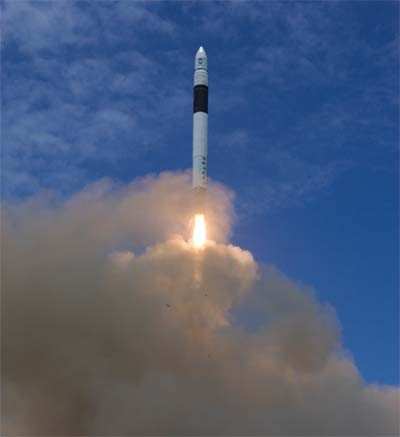And Falcon I's Stage Separation Timing Was Off This
Weekend
It was far from a perfect flight... but they now know what
happened. That's the message Elon Musk, CEO and founder of Space
Exploration Technologies (SpaceX,) had for employees Wednesday,
regarding the company's unsuccessful Falcon I launch this
weekend.

"On August 2nd, Falcon 1 executed a picture perfect first stage
flight, ultimately reaching an altitude of 217 km, but encountered a problem just
after stage separation that prevented the second stage from
reaching orbit," Musk writes. "At this point, we are certain as to
the origin of the problem. Four methods of analysis – vehicle
inertial measurement, chamber pressure, onboard video and a simple
physics free body calculation -- all give the same answer.
"The problem arose due to the longer thrust decay transient of
our new Merlin 1C regeneratively cooled engine, as compared to the
prior flight that used our old Merlin 1A ablatively cooled engine,"
Musk continues. "Unlike the ablative engine, the regen engine had
unburned fuel in the cooling channels and manifold that combined
with a small amount of residual oxygen to produce a small thrust
that was just enough to overcome the stage separation pusher
impulse."
Musk says the company was aware of the thrust transient, and had
allowed for some variance... but admits SpaceX "did not expect it
to last that long. As it turned out, a very small increase in the
time between commanding main engine shutdown and stage separation
would have been enough to save the mission.
"The question then is why didn't we catch this issue?" Musk
continues "Unfortunately, the engine chamber pressure is so low for
this transient thrust -- only about 10 psi -- that it barely
registered on our ground test stand in Texas where ambient pressure
is 14.5 psi. However, in vacuum that 10 psi chamber pressure
produced enough thrust to cause the first stage to recontact the
second stage."
Musk concluded by noting "Good Things About This Flight" --
including the excellent performance of the Merlin IC first-stage
engine, and correct stage separation sequencing and fairing
separation. While acknowledging problems encountered on each of the
company's three unsuccessful flights, Musk notes "neither the near
miss potential failures of flight two nor any new ones were
present."
Perhaps most importantly, Musk notes wryly, "We discovered this
transient problem on Falcon 1 rather than Falcon 9," which is
substantially larger.
"It looks like we may have flight four on the launch pad as soon
as next month," Musk (below) concludes. "The long gap between
flight two and three was mainly due to the Merlin 1C regen engine
development, but there are no technology upgrades between flight
three and four. The only untested portion of flight is whether or
not we have solved the main problem of flight two, where the
control system coupled with the slosh modes of the liquid oxygen
tank.

"Given the addition of slosh baffles and significant
improvements to the control logic, I feel confident that this will
not be an issue for the upcoming flight four."
 ANN's Daily Aero-Term (04.28.24): Airport Marking Aids
ANN's Daily Aero-Term (04.28.24): Airport Marking Aids Aero-News: Quote of the Day (04.28.24)
Aero-News: Quote of the Day (04.28.24) ANN's Daily Aero-Linx (04.28.24)
ANN's Daily Aero-Linx (04.28.24) Aero-News: Quote of the Day (04.29.24)
Aero-News: Quote of the Day (04.29.24) ANN's Daily Aero-Linx (04.29.24)
ANN's Daily Aero-Linx (04.29.24)




